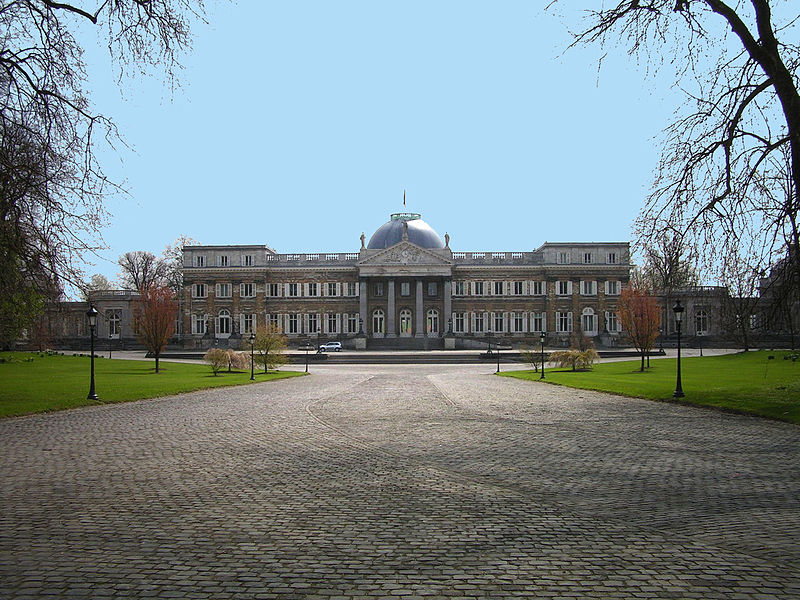by Scott Mehl © Unofficial Royalty 2015

source: Wikipedia
The Royal Palace of Laeken
The Royal Palace of Laeken is the official residence of King Philippe and Queen Mathilde of Belgium. Since Belgian independence in 1831, the palace has been the primary residence of the Belgian sovereigns, with the exception of King Albert II and Queen Paola, who chose to remain at the nearby Chateau Belvédère after his accession. The Palace is owned by the Belgian State (along with the Royal Palace of Brussels) and is placed at the disposal of the Sovereign.
At the time part of the Austrian Netherlands, the palace was built between 1782-1784 as a summer residence for the Governors of the Austrian Netherlands, Archduchess Maria Christina of Austria and her husband Duke Albert of Saxe-Teschen. After the area came under French rule in 1794, the palace was left abandoned for some time, and was near demolition. In 1804, it was purchased for 5 million francs by Napoleon Bonaparte, who went on to restore the palace to its former glory. He stayed there several times with his first wife, Josephine de Beauharnais, and later gave the property to her following their divorce.
In 1815, the Kingdom of the Netherlands was created, and the palace was acquired by King Willem I who also made renovations, adding an orangery and a theater. Following Belgian independence, the Palace of Laeken became the official residence of the newly elected King Leopold I in 1831.
It was King Leopold II (1865-1909) who made the most significant changes to the palace and the surrounding park. In 1874, he began building the Royal Greenhouses of Laeken, a project which would take over 20 years to complete. A fire in the palace on January 1, 1890 destroyed the dome and much of the north wing, which was soon rebuilt with the addition of two small pavilions on either side of the main palace block. Beginning in 1902, King Leopold II had two large wings built to flank the palace. The right-wing was to be the private apartments, while the left-wing was to be for guests. The work was not finished until after his death in 1909.
His successor, King Albert I, finished much of the remaining work. He also had an art studio built in the grounds for his wife, Queen Elisabeth (born Princess Elisabeth of Bavaria). King Albert I was succeeded by his son, King Leopold III in 1934. Within the year, Leopold’s wife Queen Astrid died tragically, and he and his children moved to the Palace of Laeken. From 1940-1944, Leopold III and his family were held under house arrest at the palace before being sent from the country. During his absence, his brother Charles, Count of Flanders, served as Regent and lived in the palace until Leopold’s return, and subsequent abdication, in 1951. Leopold was succeeded by his elder son, King Baudouin. Despite having abdicated, King Leopold III continued to live at the palace along with the new King, until Baudouin’s marriage in 1960.
After Baudouin’s death in 1993, Laeken remained the residence of his widow, Queen Fabiola. King Albert II chose to remain at Château Belvédère instead of moving to the larger palace. Queen Fabiola lived there until 1998 when she moved to the smaller Château Stuyvenberg just across the park. The Palace of Laeken then became the home of the Duke of Brabant, now King Philippe, in 1999 upon his marriage to Mathilde d’Udekem d’Acoz. Since Philippe’s accession to the throne in 2013, the Royal Palace of Laeken has once again become the home of the reigning Belgian monarch.
Along with the Royal Palace of Brussels, the Palace of Laeken is often used to host official functions including State dinners. In addition, prior to his accession, King Philippe often hosted foreign guests at the palace. The photo above shows The Prince of Wales visiting with the then-Duke and Duchess of Brabant in 2008.
The palace is situated in The Royal Domain of Laeken – a large park (the size of Monaco!) which also includes several other royal residences, the Royal Stables, the Royal Greenhouses of Laeken, the Japanese Pagoda, and the Chinese Pavilion which are part of the Museums of the Far East, as well as a lake and golf course. The other royal residences are the Château Belvédère, the home of King Albert II and Queen Paola; Château Stuyvenberg, the former home of the late Queen Fabiola; and Villa Schonenberg, the home of Princess Astrid and Prince Lorenz and their family.

The Royal Greenhouses. source: Wikipedia
The Royal Greenhouses were built by King Leopold II for the purpose of housing his vast collection of exotic and rare flowers and trees, many of which found their origins in the Congo. The buildings – particularly the large domed Winter Garden – have often been used for formal functions. The Greenhouses are open to the public for several weeks each spring.
This article is the intellectual property of Unofficial Royalty and is NOT TO BE COPIED, EDITED, OR POSTED IN ANY FORM ON ANOTHER WEBSITE under any circumstances. It is permissible to use a link that directs to Unofficial Royalty.
